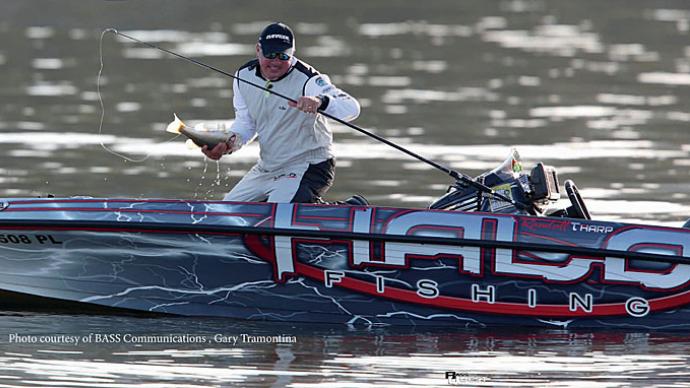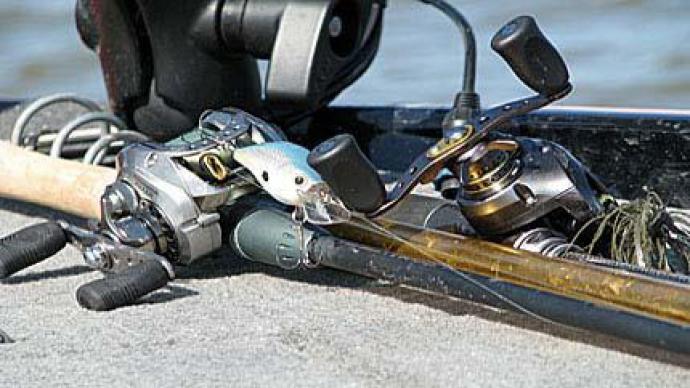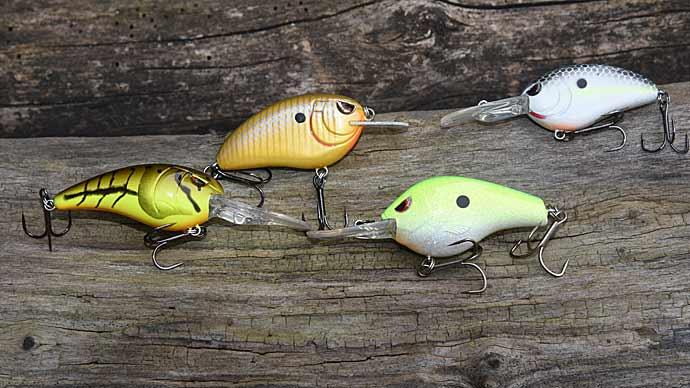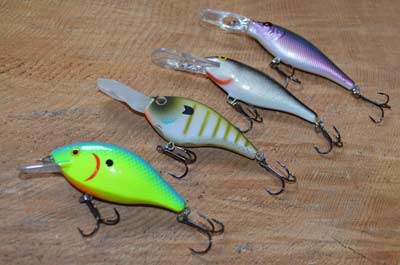
It’s a good spot — where rock, wood, and shallow and deep water meet — all year. But it’s best when winter is slipping into the past, spring is still in the future, and bass are beginning to move toward the spawn. It’s where I met one of my biggest South Carolina bass, which I caught on one of my smallest lures, a flat-sided balsa crankbait.
Cold water and flat-sided crankbaits are a productive combination. Their diving action gets them down to the bass. Their shape and tight wiggles match bass's favorite cold-water meal, baitfish. And with some finesse, they come through nearly any hard cover, which bass cling to in February.
Maximizing the effectiveness of flat-sided crankbaits requires more than simply casting and retrieving. It starts with preparation and understanding. You need to know how these crankbaits react in the water, which are best for where and when you’re fishing, and how to eke out all their productivity.
Choose Your Crankbait
Crankbaits are available in an almost endless variety, though each falls into one of two body-shape categories. There are bulbous ones whose wide wobbles attract the most bass when the water is warm. Then there are flat-sided crankbaits, such as Rapala’s Shad Rap and Berkely’s Frittside, whose tight wiggles are most productive when the water is cold. Each is engineered to behave in specific ways, whether that's wiggle, diving depth, or profile. While various components contribute to those, the most important is material.
Modern crankbait bodies are made from one of two materials — wood or plastic. Flat-sided crankbaits, for example, are available in both. Each brings strengths and weaknesses. Plastic is more prevalent among lure manufacturers, relatively inexpensive, reliable, and moldable. Bass anglers like it, too. Here's why:
- Durability: Plastic stands up to repeated impacts from rocks, docks, and wood that can damage wood. You’ll be more likely to cast a plastic crankbait into those tight spots where big bass live because you won’t be worried about damaging your lure.
- Castability: Plastic crankbaits weigh more than wooden ones of similar size. That additional mass helps with casting accuracy and ease, especially if you must step up your gear to overcome heavy cover. It’s helpful on breezy days, too.
- Sound: Constructed with an internal void, most plastic crankbaits have rattles. They can attract bass, especially in dirty water or low-light conditions. But they also can scare bass, especially those swimming in clear water or feeling fishing pressure.
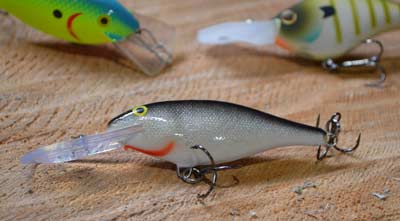
Cedar and balsa are the most common woods used to construct crankbaits. Wood is fickle; knots and density are unique to each piece, causing variations in action, even among crankbaits of the same make and model. Here’s what else you can expect from a wood crankbait:
- Buoyancy: Wooden crankbaits rise faster than plastic ones when paused. That movement can trigger strikes from following bass. And it’s helpful when bumping cover. Stop your retrieve, and your crankbait will float up and away from a snag.
- Subtilty: They are slim and quiet; few wood crankbaits contain rattles. Both heighten their realism, often an important strike provoker in clear water.
- Price: Manufacturing wood crankbaits requires more work, whether shaping the bodies or hand tuning to ensure proper action. That makes them more expensive compared to plastic versions. But when the water is coldest, that investment often pays off with more bass in your boat.
No article concerning crankbaits is complete without a discussion of bills. They bring a crankbait to life. You’ll find nearly every combination of bills attached to flat-sided crankbaits. Here's what you want for cranking in February:
- Long: Length determines diving depth. Reaching those 8- to 15-foot depths, where many bass first appear during prespawn, requires a bill equal in length to its crankbait's body. Shorter, and you'll crank right over them. Longer, and you'll be mired in the bottom.
- Slender: Look for a bill whose width is nearly equal to the crankbait’s body. It joins the flat sides to create the tight wiggles that bass prefer in February. It may flair slightly at its leading edge.
- Round: Many flat-sided crankbaits sport a rounded bill. That’s more important for you than the bass. It helps your crankbait roll around obstructions — rocks, stumps, branches — lessening its chances of snagging.
Not all bass are in the mid-depths in February. They can be on the bank in some places. So, a small square-bill crankbait can be key. But still select one with flat sides, such as Storm’s Speed Trap, which previously flew under the banner of sister lure brand Luhr Jensen. It’s an excellent choice for bouncing along a riprap bank, through laydowns on a point, or into dock posts. While its action isn’t as tight as a Shad Rap, for example, it’s closer than the bulbous square bill you tie on in the heat of summer.
Once you’ve selected a couple of flat-sided crankbaits, you must choose which pattern they sport. Two will cover nearly every February fishing situation. First, you'll want a baitfish version for clear water, which can be widespread during the late stages of winter. Runoff is usually scarce this time of year, lowering turbidity levels, even in river-run reservoirs.
Complement your baitfish models with crawfish ones. Focus on those that sport a chartreuse or orange belly. They work best when water is off-colored, usually later in February or further up a reservoir’s main river or creek arms. Bass easily find them, thanks to their splash of bright color.
Select Your Spots
Regardless of what Punxsutawney Phil says, February weather trends warmer. It can be brutal in some regions, but even bass know better days are ahead. So, they can be found in relatively shallow water — 8 feet to 15 feet — in many rivers, reservoirs, and lakes, even if the water temperature is still in the high 30s or low 40s. But as is the case the other 11 months of the year, they aren't everywhere.
Besides depth, the best spots to run a flat-sided crankbait across in February share other attributes. They’re close to vertical structure in deeper water, where bass likely spent the worst of winter. They're near or intersect structure, or in some cases cover, that bass will move along to shallow spawning sites. But most important, they are covered with one or more hard cover types — rock, wood, or manmade material.
The best spots combine many of these traits. But don't dismiss the ones with fewer. They still hold bass. Here are some places to try:
- Rocky points: Start close to deep water, focusing on ones buffeted by wind. That can corral baitfish and relatively warm water, making bass there more active.
- Laydowns: Most often associated with shallow water, they are usually best at the end of February. Focus on their deeper ends at the beginning of the month.
- Brush piles: These can be tough to find, but the effort is worth it. Return to them throughout a fishing day. Small changes in weather or the path of wandering baitfish schools can make them productive in an instant.
- Docks: These are bass magnets on many waters, especially where other cover types are absent. Aim each cast so your crankbait contacts multiple posts. The shallowest ones are many times the best.
- Bridge pilings: These offer cover across various depths, often intersecting routes bass take to spawning spots. Vary casting angles and directions until you find the one that triggers strikes.
Play Up The Pause
Bass are opportunistic feeders. While they consume many types of prey, they pick when they eat. And that's usually when an opportunity presents itself, such as an injured baitfish or where it shouldn't be. There's no better way to create those opportunities with a flat-sided crankbait than with a perfectly planned pause.
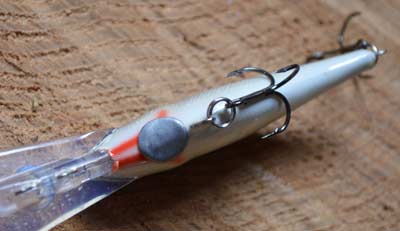
While occasional pauses during a retrieve give following bass a chance to strike, they are more powerful when they follow an impact — your crankbait crashing into cover or bottom. The impact gets their attention, and the pause makes your crankbait appear as a meal too easy to pass up.
Making the most of pauses goes beyond injecting plenty into each retrieve. You want your lure to hang nearly motionless when it pauses. While some anglers prefer it sinks slightly, and others want it to rise slowly, they all agree the longer you can make a crankbait stay in nearly one spot, the more likely a following bass, especially those whose metabolism is dulled by cold water, will inhale it.
Hang time with your flat-sided crankbait can be created in several ways. All involve adding a small amount of weight. Here are three methods:
- Heavy hooks: While the theory of changing to larger hooks is stout, it’s the wrong direction. They can easily tangle, fouling presentations. Try hooks of similar size made from heavier wire instead.
- Lead tape or wire: A time-tested approach, apply strips or dots of tape to your crankbait's belly just forward or aft of its front hook. The wire should be wrapped around the front hook's shank.
- Fluorocarbon line: Unlike monofilament, fluorocarbon line sinks. The amount needed for an average cast won’t drag your crankbait to the bottom, but it will greatly slow its rise.
Choose A Combo
Flat-sided crankbaits are relatively lightweight. So, the boom-and-crane baitcasting outfit you sling crankbaits with all summer is too much. You'll need something more than their speed. And that's a spinning outfit most of the time. They're better suited to handle light line — 8- to 12-pound test — and require only a bit of weight to load completely, which launches longer and more accurate casts.
If you are set on using a baitcasting combo, find a cranking rod with medium-light power. Match it to a small reel whose spool spins freely without the brakes being turned off all the way. Diving into BFS — bait finesse system — which is intended for small lures is an option, too.
Whether spinning or baitcasting, your outfit needs to be set up correctly. That’ll help you better present your flat-sided crankbait and land the bass that bite it. Make sure you do these three things:
- Smooth drag: Set it properly. Relatively small treble hooks and lightweight line make it easy for a surging bass to pull or break free. A drag that slips at the perfect moment will save the day.
- Thin line: It cuts through the water better, helping your crankbait reach deeper depths. It also is easy to cast and allows lightweight lures freedom to create action.
- Moderate action: Choose a rod that flexes at least halfway down the blank. They load with less weight, allowing you to cast small crankbaits farther and act as a shock absorber, keeping bass hooked.


